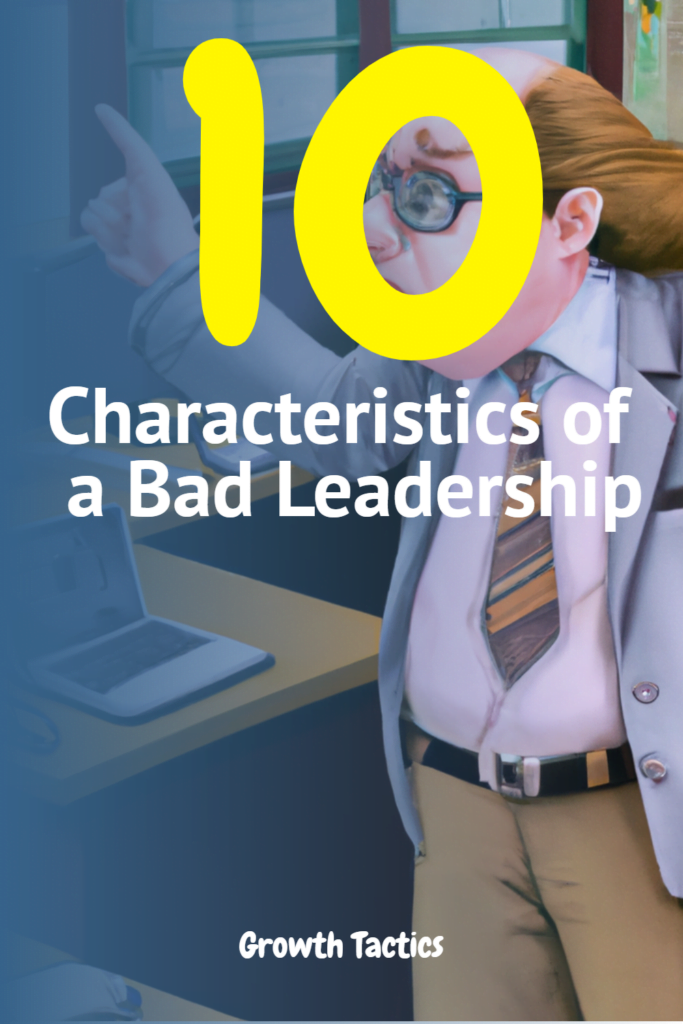In my experience, the ripple effects of bad leadership can be devastating. Leading to a demoralized workforce, high employee turnover, and ultimately, organizational decline. Poor leadership undermines trust, stifles growth, and creates a toxic work culture that can suffocate any signs of progress or innovation. To prevent such detrimental outcomes, it’s crucial to be vigilant about the leadership qualities we cultivate and endorse within our organizations or even within ourselves.
Below, we will explore various characteristics of bad leadership. Recognizing these red flags can be the first step in addressing and rectifying leadership shortcomings, ensuring you or your organization can set a course for success, guided by strong, effective leadership.
Jump To Section
Characteristics of a Bad Leader
Let’s get into specific traits that typify ineffective leadership. Understanding these traits can enlighten current and aspiring leaders about what to avoid and can also help team members and other stakeholders identify and address leadership concerns in their organizations.
Poor Communication
The cornerstone of any successful team is clear, concise, and effective communication. When a leader lacks the necessary communication skills, the result can be catastrophic for their team. Poor communication leads to a lack of direction, leaving team members feeling lost and unsure of their objectives. This ambiguity fuels confusion and fosters an environment ripe for misunderstandings and mistakes.
Team members rely on their leaders not only for direction but also for inspiration and motivation. When communication is insufficient, team spirit dwindles, and individuals can quickly become disengaged and frustrated. Conversely, leaders who prioritize open and transparent communication channels foster a sense of security and clarity that allows every team member to flourish. In such environments, individuals know exactly what is expected of them, can align their efforts with the organization’s goals, and feel valued and heard.
Leaders are Indecisive
When leaders are unable to make decisions in a timely manner, the entire momentum of a team can grind to a halt. Indecisiveness at the leadership level can be especially damaging when quick, decisive action is needed. The inability to choose a course of action not only slows down project timelines but also signals a lack of confidence, which can quickly spread throughout the team, eroding morale and respect for leadership.
Decisiveness is not about making decisions hastily but about making informed choices with conviction and then standing by them. It is a critical component of leadership that supports the smooth operation of an organization and assures team members that their efforts are driven by a strong, determined hand. A decisive leader boosts team confidence, encourages swift and effective action, and keeps projects on track to achieve their goals.
Bad Leadership Traits: Micromanagement

Micromanagement is an all-too-common trait of poor leadership. Leaders who micromanage often believe they are ensuring tasks are completed to a specific standard. However, this overbearing approach strips employees of the ability to work independently, stifling their development, and causing frustration. It erodes trust, as team members feel their leader does not have confidence in their capabilities and can diminish their sense of ownership and accountability for their work.
Empowering employees by allowing them autonomy is not just about delegating tasks; it’s about entrusting them with the responsibility to make decisions and the freedom to develop their approach to their work. This trust breeds confidence and innovation, as team members feel they have the support to take risks and think outside the box. Giving employees space to breathe and grow can lead to higher job satisfaction, retention, and productivity. Leaders should strive to guide rather than to control, enabling their teams to do their best work.
Poor Conflict Resolution Skills
Conflict is an inevitable part of any workplace. When it occurs, the manner in which it’s handled can either strengthen a team or lead to lasting discord. Leaders with adept conflict resolution skills are essential for maintaining a positive, collaborative, and harmonious work environment. Conversely, leaders who lack these skills may inadvertently escalate conflicts, potentially causing a situation to spiral out of control.
Poor conflict resolution can manifest in various ways: avoidance of the issue, passive-aggressive behavior, or even aggression. Such actions, or inactions, can lead to a toxic atmosphere that undermines teamwork and productivity. Effective leaders understand that addressing conflict head-on, with tact and empathy, can turn what might seem like a setback into an opportunity for growth and understanding.
A leader adept in conflict resolution listens to all parties impartially, seeks to understand the root causes of the disagreement, and works collaboratively to find solutions that are agreeable to all involved. By doing this, leaders not only resolve the immediate issue but also set the standard for how conflicts should be handled in the future, ultimately fostering a resilient and respectful team culture.
Leaders being Ego-Driven
Ego-driven leadership can severely hinder a team’s spirit and organizational success. Leaders prioritizing their ego often disregard the collective needs, leading to reckless decision-making and favoritism, which breed a toxic work culture. Such leaders tend to ignore feedback, suppress collaboration, and promote an environment where trust and communication suffer.
This behavior not only demoralizes the team but also impacts the organization’s overall performance and culture, making it difficult to foster innovation or maintain high morale. Ultimately, the key to sustainable success lies in leaders putting the organization’s and team’s needs above their own, ensuring a supportive and inclusive atmosphere where every member feels valued.
Signs of Ineffective Leadership: Lack of Strategic Thinking
Strategic thinking is the capacity to look beyond the day-to-day operations and plan for the future. It involves setting goals, anticipating trends, and preparing for challenges. Leaders who lack strategic thinking are often caught off guard by events, leading to reactionary measures rather than proactive planning. This can result in missed opportunities and a failure to capitalize on potential growth avenues for the organization.
Without a strategic approach, leaders may find themselves navigating without a map, making short-term decisions that are incongruent with the long-term vision or, worse still, having no vision at all. Strategic thinking encompasses not only the formulation of a compelling vision but also the ability to communicate and implement it effectively.
A leader who is strategically adept can steer the organization through complex and changing environments, adapting and innovating as required. Strategic leaders are also skilled at rallying their team around common goals, providing a sense of purpose and direction that drives collective effort.
Qualities of a Bad Leader: Not Prioritizing Leadership Development
Leadership is not a static skill set; it requires continual evolution and adaptation. Leaders who do not prioritize their personal development can quickly become antiquated in their methods, failing to meet the changing needs of their teams and organizations. By ignoring the need for ongoing leadership development, a leader risks becoming ineffective, and unable to inspire or provide effective guidance.
Constant improvement should be a hallmark of good leadership. This includes seeking feedback, embracing learning opportunities, and staying abreast of the latest in leadership theories and practices. It also involves nurturing soft skills such as empathy, emotional intelligence, and resilience.
Leaders who dedicate themselves to personal growth and development set a powerful example for their teams, showing that progress and improvement are valued and expected. They recognize that as they grow, they are better equipped to support their team’s growth, promote innovation, and maintain a competitive edge. Leadership development is not just a personal investment but also an investment in the health and future of the entire organization.
Characteristics of Bad Leadership in Conflict Resolution
Effective conflict resolution is a defining trait of good leaders. On the flip side, characteristics of bad leadership become glaringly apparent when conflicts arise and are mishandled. Poor approaches to conflicts include jumping to conclusions without gathering adequate information, taking sides without a fair analysis, or dismissing concerns altogether. These actions signal to team members that their issues are not important and can fuel a sense of injustice and resentment.
Leaders who lack the skills or the will to navigate conflicts can inadvertently allow the dispute to fester, which may snowball into larger issues that could have been contained early on. Furthermore, avoiding the resolution of conflicts communicates to team members that such issues are not a priority and that harmony within the team is not valued. This negligence can lead to a toxic work culture where gossip, backstabbing, and dissatisfaction thrive. By not effectively addressing tensions, a bad leader can severely impair team morale and productivity.
Poor Leadership Qualities: Not Supporting Team Members
The role of a leader extends beyond simply overseeing the workflow. It involves nurturing a team, recognizing their achievements, and facilitating their professional development. Leaders who fail to do this may create an environment where team members feel undervalued and unseen. This negligence can manifest as a lack of recognition for hard work, inadequate support during challenging tasks, or limited opportunities for professional growth and skill advancement.
A leader who does not invest in their team will likely witness the repercussions through high turnover rates and low employee engagement. A strong indication of poor leadership is when team members consistently seek opportunities elsewhere because their current environment does not foster growth or appreciation. Such leaders not only lose valuable talent but also incur additional costs in recruiting and training new employees while potentially damaging the organization’s reputation as an employer.
Lack of Vision
An effective leader not only manages the day-to-day operations but also sets a clear vision for the future, providing direction and inspiration. A lack of vision is a red flag in leadership, as it suggests an absence of strategic planning and goal-setting. Without a vision, there is no roadmap for success, and team initiatives can become disjointed and aimless.
Visionary leadership involves imagining the possible and not just the probable, looking forward with optimism and creativity to set a course that motivates and unites team members. A lack of vision from the top can lead to a stagnant atmosphere where innovation is stifled and growth is hampered. As the team wanders without a clear purpose, morale will likely diminish, with individuals unable to see how their contributions fit within the larger picture. An effective leader, therefore, must be someone who not only dreams but conveys those dreams in a way that enthuses their team and coalesces their shared efforts toward a compelling and tangible future.
The Impact of a Bad Boss on Team Dynamics
A bad boss can significantly disrupt the dynamics within a team. Leadership behavior directly influences the trust, communication, and cooperation levels among team members. For example, leaders who openly show favoritism can create divisions within the team, leading to an atmosphere of competition and suspicion rather than collaboration. When a boss is consistently negative or overly critical without offering constructive feedback, it can erode self-esteem and hinder initiative among team members.
Additionally, if a leader is prone to outbursts or displays unethical behavior, it can lead to an erosion of respect and trust. This trickle-down effect means that team members may become less inclined to support each other, share information, and work together effectively. The end result is a team that lacks cohesion and unity. Leaders who demonstrate poor leadership through their behavior send a message that such traits are tolerated or even endorsed, potentially leading to widespread negativity within the team.
Conclusion: The Path to Good Leadership
In conclusion, overcoming the detrimental traits of bad leadership is crucial not only for the individual’s growth but also for the cultivation of a positive and productive work environment. Leaders who recognize and address their tendencies towards ego-driven decisions, lack of vision, and poor conflict resolution set the stage for a more inclusive, innovative, and successful organization.
It is through self-reflection and an ongoing commitment to personal and professional development that leaders can transform challenges into opportunities for growth. Therefore, leaders across all levels are urged to periodically assess their leadership style and seek continuous improvement.
By fostering self-awareness and embracing change, leaders can significantly impact their teams and organizations positively. The call to action is clear: prioritizing self-improvement and the welfare of your team not only marks the path toward effective leadership but also ensures a thriving, dynamic work culture.


